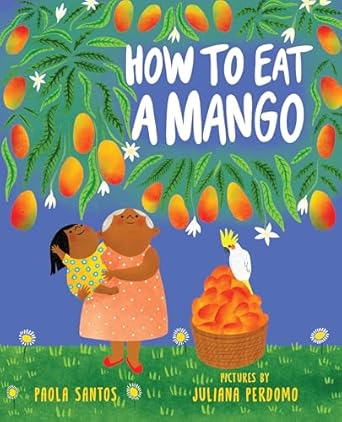How to Eat a Mango

How to Eat a Mango
“But Abuelita, I don’t know how to peel mangoes like you!” I say.
“It’s easy, mi amor,” she tells me. “Tear the tippy top with your teeth, and with your hands, open it wide.”
“Inside,” she continues, “a lazy golden liquid waits to slide down your arms, slow, like a yawn under a midday sun,”
“It’s like when we get sleepy after lunch.”
“You’re right, mi amor. And now … the best part.”
Carmencita gripes when she is tasked with helping her Abuelita pick mangoes. The little girl is adamant that she doesn’t like the sweet fruit and complains how mangoes are “sticky and get stuck between my teeth!” Abuelita encourages the child to use all of her senses to appreciate the many fruits the mango tree has to offer.
Together, the elder and her grandchild listen to the musicality of the mango tree’s long green leaves swaying in breeze: “They whistle stories of sunrays and rain and those under its shade. They call us by name.” The soft, comforting sounds remind Carmencita of her mother’s voice singing to her in the morning. With ears to the ground, Abuelita and Carmencita eavesdrop on the mango tree’s roots drinking up water and whispering “Gracias Thank you!’ to Mama Earth. The child reflects on parallels to her own life, like the gratitude her family shows to each other: “At bedtime, we say gracias for Mami and Papi and you, Abuelita.”
As the sensory nature exploration continues, the sight of strong branch limbs and the touch of the mangoes’ smooth skin brings to mind how families carry each other and hold loved ones close. The “honey-sweet” smell of ripe mangoes is likened to “an offering of love from the earth and the sun and the sky above.” When Abuelita shows the child how to peel mangoes and to take a tantalizing first bite, a taste sensation explosion is celebrated: “the songs of our people dance on your tongue.”
Juliana Perdomo’s dynamic digital illustrations burst with colour and warmth. Familial love and deep, enduring intergenerational connections are ever present in background details, like the yellow blooming cayenas planted in the garden to remember Abuelito.
Debut author Paola Santos’ slice-of- life text, told from the child’s first-person point of view, is poetic and inviting. Spanish words are conversationally sprinkled throughout. In an endnote, Santos shares details about her culture, life and childhood memories of growing up in Venezuela.
Extolling the joys to be found in fully appreciating what is close at hand and sometimes taken for granted, How to Eat a Mango is a delicious picture book to savour.
Linda Ludke is a librarian in London, Ontario.
